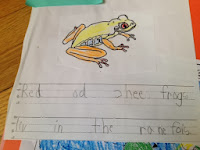I read with great interest about the stages of spelling
development in the text (Literacy’s
Beginnings: Supporting Young Readers and Writers), and looked back at my
daughter’s portfolio of kindergarten work to see if I could identify her progression
through these stages. I could clearly see evidence of these stages; she appears
to have started the year somewhere between emergent spelling and early
letter-name spelling. Here, in the first week or two of school, she is using
the beginning consonant “K” for couch.
By the end of the year, she seems to be well into middle or
perhaps later letter-name spelling…
But I was even more interested in the authors’ statement
that the role of the teacher is not to categorize the student but to support
the student’s “continued development so that over time, his spellings resemble
later stages more often than earlier stages” (p.106). This is a spot-on
description of what I saw in the progression of my daughter’s work over the
course of the year. She began the year by needing a great deal of teacher
support, but as she gained competence, the teacher gradually scaled back on her
scaffolding.
Early on in the year, the teacher was sometimes writing her
dictated words…
Or writing the words in a yellow marker for my daughter to
write over…
As my daughter learned to write her letters, she did so
painstakingly, but was still supported by having the text available for her to
refer to…
As the year progressed, she was able to write more words
independently, and the scaffolding was gradually removed. Now, we see fairly simple words, with many
high frequency words, others that she is trying to work out sound-by-sound, and
others that she is writing from a model. These sentences are from February and
March…
By April, she is fairly secure with high frequency words and
independently trying to figure out some other mysteries, (i.e. “bacre” for
bakery, “becus” for because and “cockys” for cookies).
By the end of the year, she is independently writing, with
lots of invented spellings…
Looking back at her work over the course of the year gave me
an even greater appreciation for her teacher, who gave her generous support at
the beginning of the year and gradually backed away from that support as she
became more competent. She moved from not being able to identify or write all
of her letters to becoming secure in writing all her upper and lower case
letters, developing a solid grasp of most consonant sounds, and having a good understanding
of short vowel sounds as well as a beginning awareness of long vowel sounds (i.e.
using a vowel marker to make the long E sound in “beich”).
Comparing her work from the beginning to the end of the year reinforces to me the great leap that occurs during this crucial year.
McGee, L.M. & Richgels,
D.J. (2012). Literacy’s beginnings:
Supporting young readers and writers (6th ed.). Boston, MA: Pearson Education, Inc.











